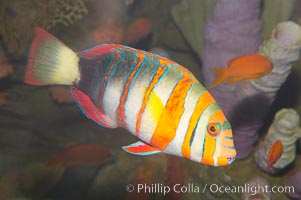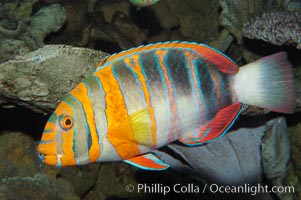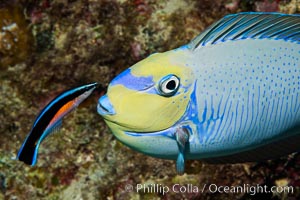
Bignose Unicornfish, Naso vlamingii, being cleaned by a small wrasse, Fiji.
Species: Bignose unicornfish, Naso vlamingii
Location: Namena Marine Reserve, Namena Island, Fiji
Image ID: 34735
Species: Bignose unicornfish, Naso vlamingii
Location: Namena Marine Reserve, Namena Island, Fiji
Image ID: 34735
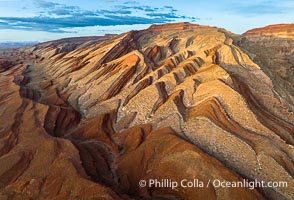
Aerial Photo of Raplee Ridge near Mexican Hat, Utah. Raplee Ridge is a spectacular series of multicolored triangular flatirons near the San Juan River. Often called "the Raplee Anticline" the geologic structure is in fact better described as a monocline, according to the Utah Geological Survey.
Location: Mexican Hat, Utah
Image ID: 39489
Location: Mexican Hat, Utah
Image ID: 39489
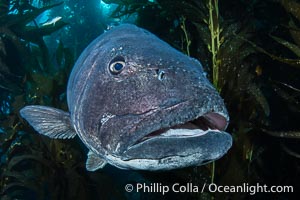
Closeup Portrait of the Face of a Giant Black Sea Bass, showing parasitic sea lice. These parasites find their nutrition from the skin and blood of the host giant sea bass. Smaller fishes such as senoritas and wrasses will commonly clean the sea lice off the giant sea bass.
Species: Giant black sea bass, Stereolepis gigas
Location: Catalina Island, California
Image ID: 39436
Species: Giant black sea bass, Stereolepis gigas
Location: Catalina Island, California
Image ID: 39436
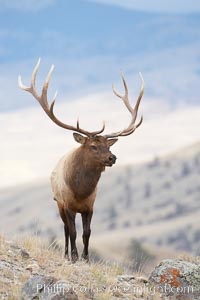
Elk, bull elk, adult male elk with large set of antlers. By September, this bull elk's antlers have reached their full size and the velvet has fallen off. This bull elk has sparred with other bulls for access to herds of females in estrous and ready to mate.
Species: Elk, Cervus canadensis
Location: Mammoth Hot Springs, Yellowstone National Park, Wyoming
Image ID: 19721
Species: Elk, Cervus canadensis
Location: Mammoth Hot Springs, Yellowstone National Park, Wyoming
Image ID: 19721
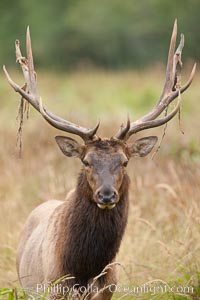
Roosevelt elk, adult bull male with large antlers. This bull elk has recently shed the velvet that covers its antlers. While an antler is growing, it is covered with highly vascular skin called velvet, which supplies oxygen and nutrients to the growing bone; once the antler has achieved its full size, the velvet is lost and the antler's bone dies. This dead bone structure is the mature antler, which is itself shed after each mating season. Roosevelt elk grow to 10' and 1300 lb, eating grasses, sedges and various berries, inhabiting the coastal rainforests of the Pacific Northwest.
Species: Roosevelt elk, Cervus canadensis roosevelti
Location: Redwood National Park, California
Image ID: 25890
Species: Roosevelt elk, Cervus canadensis roosevelti
Location: Redwood National Park, California
Image ID: 25890
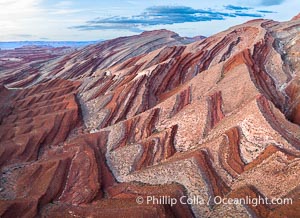
Aerial Photo of Raplee Ridge near Mexican Hat, Utah. Raplee Ridge is a spectacular series of multicolored triangular flatirons near the San Juan River. Often called "the Raplee Anticline" the geologic structure is in fact better described as a monocline, according to the Utah Geological Survey.
Location: Mexican Hat, Utah
Image ID: 39490
Location: Mexican Hat, Utah
Image ID: 39490
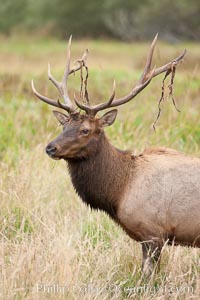
Roosevelt elk, adult bull male with large antlers. This bull elk has recently shed the velvet that covers its antlers. While an antler is growing, it is covered with highly vascular skin called velvet, which supplies oxygen and nutrients to the growing bone; once the antler has achieved its full size, the velvet is lost and the antler's bone dies. This dead bone structure is the mature antler, which is itself shed after each mating season. Roosevelt elk grow to 10' and 1300 lb, eating grasses, sedges and various berries, inhabiting the coastal rainforests of the Pacific Northwest.
Species: Roosevelt elk, Cervus canadensis roosevelti
Location: Redwood National Park, California
Image ID: 25878
Species: Roosevelt elk, Cervus canadensis roosevelti
Location: Redwood National Park, California
Image ID: 25878
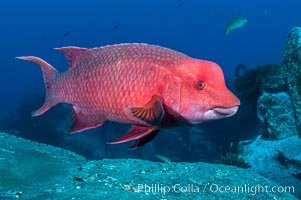
Mexican hogfish, adult male showing fleshy bump on head.
Species: Mexican hogfish, Bodianus diplotaenia
Location: Guadalupe Island (Isla Guadalupe), Baja California, Mexico
Image ID: 09606
Species: Mexican hogfish, Bodianus diplotaenia
Location: Guadalupe Island (Isla Guadalupe), Baja California, Mexico
Image ID: 09606
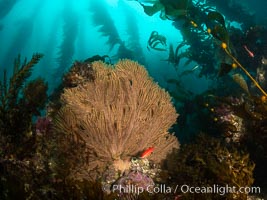
California golden gorgonian and small juvenile sheephead fishes on rocky reef, below kelp forest, underwater. The golden gorgonian is a filter-feeding temperate colonial species that lives on the rocky bottom at depths between 50 to 200 feet deep. Each individual polyp is a distinct animal, together they secrete calcium that forms the structure of the colony. Gorgonians are oriented at right angles to prevailing water currents to capture plankton drifting by.
Species: California golden gorgonian, Muricea californica
Location: San Clemente Island, California
Image ID: 37057
Species: California golden gorgonian, Muricea californica
Location: San Clemente Island, California
Image ID: 37057
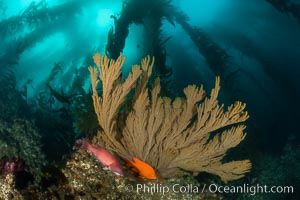
Sheephead wrasse, Garibaldi and golden gorgonian, with a underwater forest of giant kelp rising in the background, underwater.
Species: California golden gorgonian, Garibaldi, Hypsypops rubicundus, Muricea californica
Location: San Clemente Island, California
Image ID: 37093
Species: California golden gorgonian, Garibaldi, Hypsypops rubicundus, Muricea californica
Location: San Clemente Island, California
Image ID: 37093
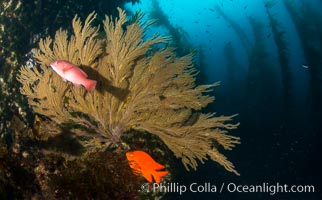
California golden gorgonian, Garibaldi and Sheephead wrasse fishes on rocky reef, below kelp forest, underwater. The golden gorgonian is a filter-feeding temperate colonial species that lives on the rocky bottom at depths between 50 to 200 feet deep. Each individual polyp is a distinct animal, together they secrete calcium that forms the structure of the colony. Gorgonians are oriented at right angles to prevailing water currents to capture plankton drifting by.
Species: California golden gorgonian, California sheephead wrasse, Garibaldi, Hypsypops rubicundus, Muricea californica, Semicossyphus pulcher
Location: San Clemente Island, California
Image ID: 30922
Species: California golden gorgonian, California sheephead wrasse, Garibaldi, Hypsypops rubicundus, Muricea californica, Semicossyphus pulcher
Location: San Clemente Island, California
Image ID: 30922
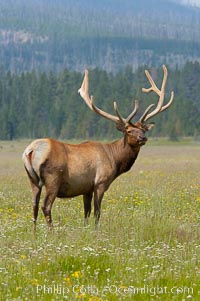
Bull elk, antlers bearing velvet, Gibbon Meadow. Elk are the most abundant large mammal found in Yellowstone National Park. More than 30,000 elk from 8 different herds summer in Yellowstone and approximately 15,000 to 22,000 winter in the park. Bulls grow antlers annually from the time they are nearly one year old. When mature, a bulls rack may have 6 to 8 points or tines on each side and weigh more than 30 pounds. The antlers are shed in March or April and begin regrowing in May, when the bony growth is nourished by blood vessels and covered by furry-looking velvet.
Species: Elk, Cervus canadensis
Location: Gibbon Meadows, Yellowstone National Park, Wyoming
Image ID: 13154
Species: Elk, Cervus canadensis
Location: Gibbon Meadows, Yellowstone National Park, Wyoming
Image ID: 13154
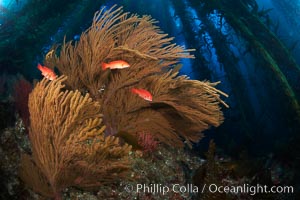
California golden gorgonian and small juvenile sheephead fishes on rocky reef, below kelp forest, underwater. The golden gorgonian is a filter-feeding temperate colonial species that lives on the rocky bottom at depths between 50 to 200 feet deep. Each individual polyp is a distinct animal, together they secrete calcium that forms the structure of the colony. Gorgonians are oriented at right angles to prevailing water currents to capture plankton drifting by.
Species: California golden gorgonian, Muricea californica, Semicossyphus pulcher
Location: San Clemente Island, California
Image ID: 23421
Species: California golden gorgonian, Muricea californica, Semicossyphus pulcher
Location: San Clemente Island, California
Image ID: 23421
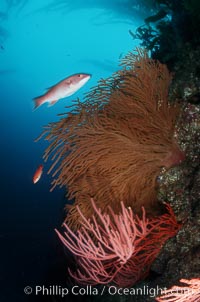
California Golden gorgonian, red gorgonian, sheephead.
Species: California golden gorgonian, Red gorgonian, Leptogorgia chilensis, Lophogorgia chilensis, Muricea californica, Semicossyphus pulcher
Location: San Clemente Island, California
Image ID: 02533
Species: California golden gorgonian, Red gorgonian, Leptogorgia chilensis, Lophogorgia chilensis, Muricea californica, Semicossyphus pulcher
Location: San Clemente Island, California
Image ID: 02533
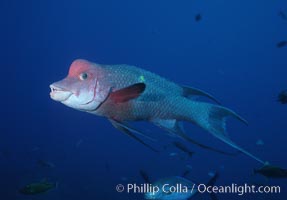
Mexican hogfish, adult male showing fleshy bump on head, Revilligigedos.
Species: Mexican hogfish, Bodianus diplotaenia
Image ID: 05768
Species: Mexican hogfish, Bodianus diplotaenia
Image ID: 05768
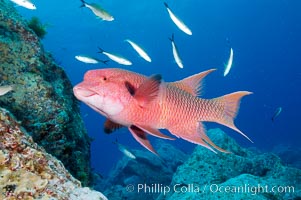
Mexican hogfish, adult male showing fleshy bump on head.
Species: Mexican hogfish, Bodianus diplotaenia
Location: Guadalupe Island (Isla Guadalupe), Baja California, Mexico
Image ID: 09609
Species: Mexican hogfish, Bodianus diplotaenia
Location: Guadalupe Island (Isla Guadalupe), Baja California, Mexico
Image ID: 09609
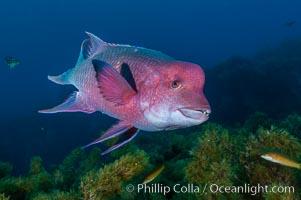
Mexican hogfish, adult male showing fleshy bump on head.
Species: Mexican hogfish, Bodianus diplotaenia
Location: Guadalupe Island (Isla Guadalupe), Baja California, Mexico
Image ID: 09618
Species: Mexican hogfish, Bodianus diplotaenia
Location: Guadalupe Island (Isla Guadalupe), Baja California, Mexico
Image ID: 09618
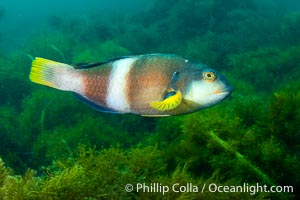
Bluethroat Wrasse, Notolabrus tetricus, Adult Male, Kangaroo Island, South Australia.
Species: Bluethroat Wrasse, Notolabrus tetricus
Location: Kangaroo Island, South Australia
Image ID: 39227
Species: Bluethroat Wrasse, Notolabrus tetricus
Location: Kangaroo Island, South Australia
Image ID: 39227
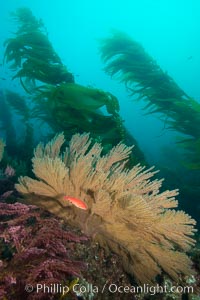
California golden gorgonian and small juvenile sheephead fishes on rocky reef, below kelp forest, underwater. The golden gorgonian is a filter-feeding temperate colonial species that lives on the rocky bottom at depths between 50 to 200 feet deep. Each individual polyp is a distinct animal, together they secrete calcium that forms the structure of the colony. Gorgonians are oriented at right angles to prevailing water currents to capture plankton drifting by.
Species: California sheephead wrasse, Semicossyphus pulcher
Location: San Clemente Island, California
Image ID: 30903
Species: California sheephead wrasse, Semicossyphus pulcher
Location: San Clemente Island, California
Image ID: 30903
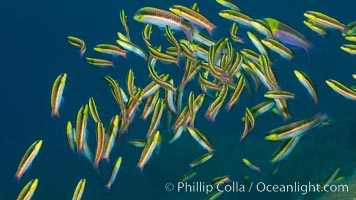
Cortez rainbow wrasse schooling over reef in mating display, Sea of Cortez, Baja California, Mexico.
Species: Rainbow wrasse, Thalassoma lucasanum
Location: Sea of Cortez, Baja California, Mexico
Image ID: 27576
Species: Rainbow wrasse, Thalassoma lucasanum
Location: Sea of Cortez, Baja California, Mexico
Image ID: 27576
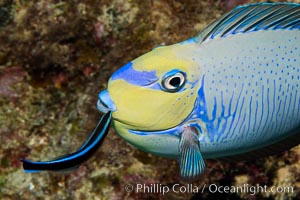
Bignose Unicornfish, Naso vlamingii, being cleaned by a small wrasse, Fiji.
Species: Bignose unicornfish, Naso vlamingii
Location: Namena Marine Reserve, Namena Island, Fiji
Image ID: 34998
Species: Bignose unicornfish, Naso vlamingii
Location: Namena Marine Reserve, Namena Island, Fiji
Image ID: 34998
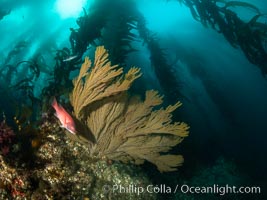
California golden gorgonian and small juvenile sheephead fishes on rocky reef, below kelp forest, underwater. The golden gorgonian is a filter-feeding temperate colonial species that lives on the rocky bottom at depths between 50 to 200 feet deep. Each individual polyp is a distinct animal, together they secrete calcium that forms the structure of the colony. Gorgonians are oriented at right angles to prevailing water currents to capture plankton drifting by.
Species: California golden gorgonian, Muricea californica
Location: San Clemente Island, California
Image ID: 37095
Species: California golden gorgonian, Muricea californica
Location: San Clemente Island, California
Image ID: 37095
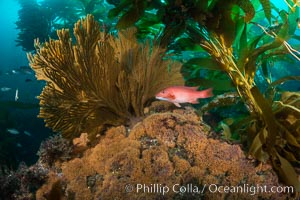
California golden gorgonian and Sheephead wrasse fish on rocky reef, below kelp forest, underwater. The golden gorgonian is a filter-feeding temperate colonial species that lives on the rocky bottom at depths between 50 to 200 feet deep. Each individual polyp is a distinct animal, together they secrete calcium that forms the structure of the colony. Gorgonians are oriented at right angles to prevailing water currents to capture plankton drifting by.
Location: Catalina Island, California
Image ID: 34183
Location: Catalina Island, California
Image ID: 34183
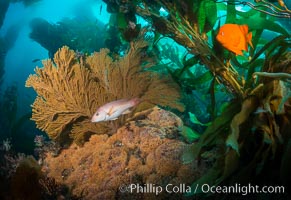
California golden gorgonian, Garibaldi and Sheephead wrasse fishes on rocky reef, below kelp forest, underwater. The golden gorgonian is a filter-feeding temperate colonial species that lives on the rocky bottom at depths between 50 to 200 feet deep. Each individual polyp is a distinct animal, together they secrete calcium that forms the structure of the colony. Gorgonians are oriented at right angles to prevailing water currents to capture plankton drifting by.
Location: Catalina Island, California
Image ID: 34186
Location: Catalina Island, California
Image ID: 34186
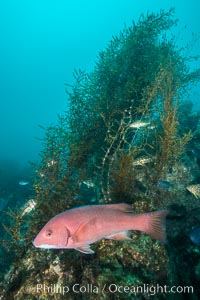
Sheephead and invasive sargassum, Catalina.
Species: Sargassum, Sheephead wrasse, Sargassum horneri, Semicossyphus pulcher
Location: Catalina Island, California
Image ID: 30974
Species: Sargassum, Sheephead wrasse, Sargassum horneri, Semicossyphus pulcher
Location: Catalina Island, California
Image ID: 30974
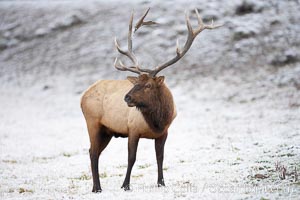
Large male elk (bull) in snow covered meadow near Madison River. Only male elk have antlers, which start growing in the spring and are shed each winter. The largest antlers may be 4 feet long and weigh up to 40 pounds. Antlers are made of bone which can grow up to one inch per day. While growing, the antlers are covered with and protected by a soft layer of highly vascularised skin known as velvet. The velvet is shed in the summer when the antlers have fully developed. Bull elk may have six or more tines on each antler, however the number of tines has little to do with the age or maturity of a particular animal.
Species: Elk, Cervus canadensis
Location: Yellowstone National Park, Wyoming
Image ID: 19692
Species: Elk, Cervus canadensis
Location: Yellowstone National Park, Wyoming
Image ID: 19692
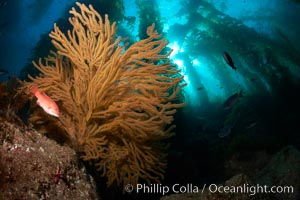
California sheephead and golden gorgonian, giant kelp forest filters sunlight in the background, underwater.
Species: California sheephead wrasse, Muricea californica, Semicossyphus pulcher
Location: Catalina Island, California
Image ID: 23449
Species: California sheephead wrasse, Muricea californica, Semicossyphus pulcher
Location: Catalina Island, California
Image ID: 23449
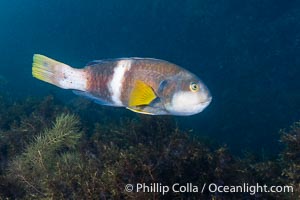
Bluethroat Wrasse, Notolabrus tetricus, Adult Male, Kangaroo Island, South Australia.
Species: Bluethroat Wrasse, Notolabrus tetricus
Location: Kangaroo Island, South Australia
Image ID: 39238
Species: Bluethroat Wrasse, Notolabrus tetricus
Location: Kangaroo Island, South Australia
Image ID: 39238
